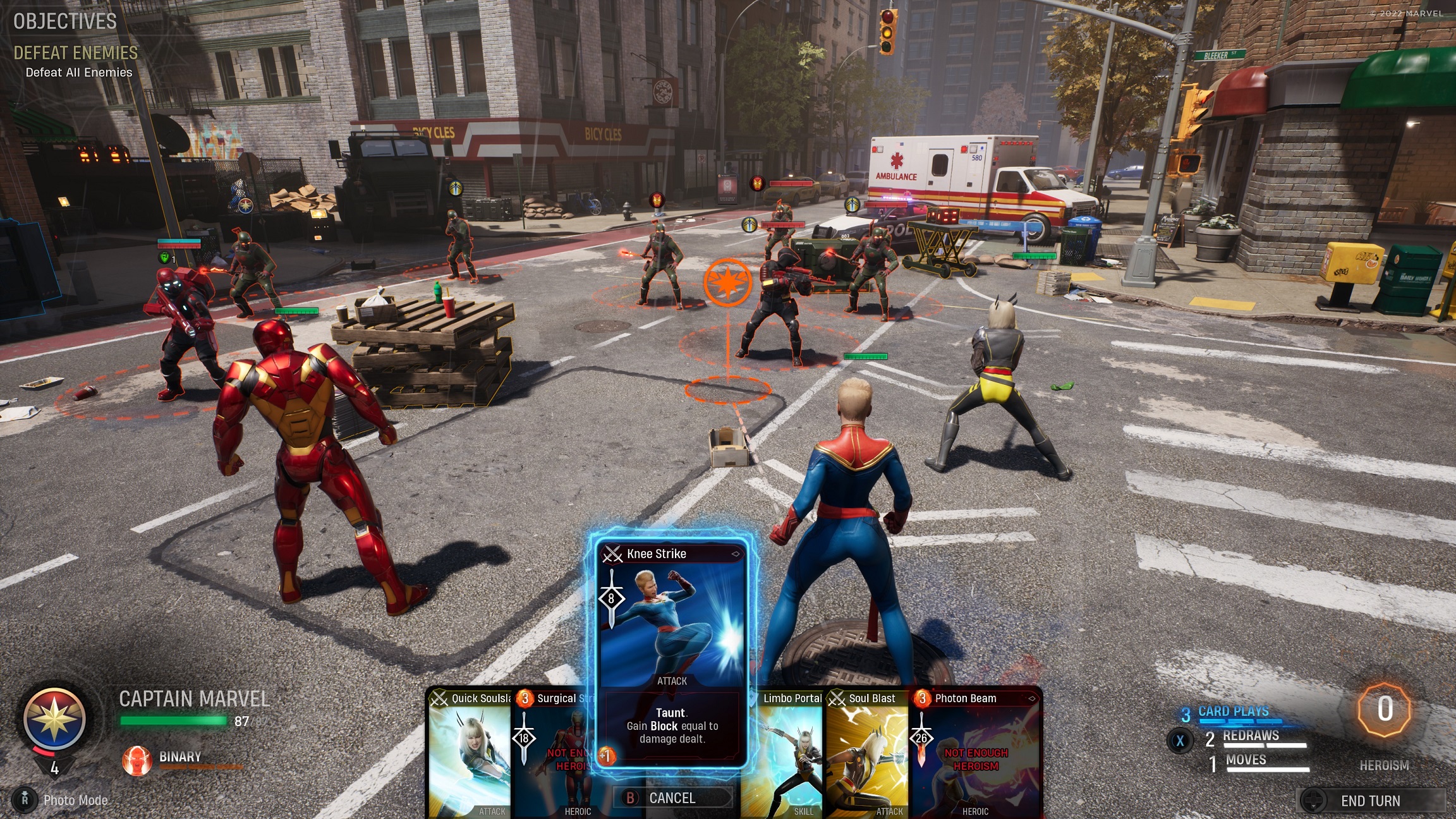Available On: PC, PlayStation, Xbox
Played On: PlayStation 5
Marvel’s Midnight Suns proves that the Marvel IP can grow far beyond the typical MCU-based action-adventure game.
Developed by Firaxis, makers of Civilization and XCOM, Midnight Suns is a unique combination of RPG party headquarters, Persona-like daily activities and relationship building, and a tactical, turn-based card battler. Astonishingly, all those pieces are well-designed and enjoyable executed, giving us one of the most memorable and enjoyable Marvel games in years.
Hell on Earth
The Midnight Suns are a group of of supernatural evil-battling superheroes named after an apocalyptic event. In the early events of the story, they’re joined by key members of the Avengers as a new big bad, a demon lady named Lilith, is resurrected by villainous group Hydra.
Our heroes have one ace in the hole — Lilith’s own child, known as The Hunter. The Hunter is the customizable player character, including gender, and acts as a helpful newcomer for meeting and befriending all of these famous (and not so famous) heroes.
I love the Marvel Cinematic Universe, but Marvel is so much more (even as the MCU continues to expand). Midnight Suns, based on a comic series that originally began in the 1990s, stars many familiar heroes, such as Spider-Man, Iron Man, Captain Marvel, and Doctor Strange, while throwing in a few delightful lesser-knowns, such as Ghost Rider (Robbie Reyes), Magik, and Nico.
Each hero has their own deck of eight cards, and their own gameplay style. Captain Marvel can transform into her binary mode after playing enough cards, gaining tons of block and attack boosts, but also drawing the attention of enemies. She pairs well with more supportive heroes such as Doctor Strange and Nico, who can generate heroism (the resource for playing the most powerful cards) and apply important buffs and heals.
Captain America blocks and protects others, Blade specializes in bleed and lifesteal, while The Hunter is adaptable to be a powerhouse bruiser, or support, or anywhere in between, depending on the cards we unlock and select for our deck.
Three heroes can be taken on a mission, with only main story missions requiring The Hunter. The three hero decks are shuffled together to create a single deck, creating turn-by-turn strategies based on the heroes, the cards in their decks, and the current cards in our hand. Not to mention the enemies we’re facing, what they’re doing, and the environment we’re battling in.
Level design is smaller and more intimate than XCOM, consisting of little more than an arena. But these battle arenas are filled with interactive objects, such as boxes, pallets, cranes, and generators. Thanks to frequent knockback attacks, and being able to manipulate objects using heroism, Midnight Suns encourages me to make the most of every object in a level, creating an additional layer of strategically satisfying decisions on every turn.
Abbey Road
Between missions, The Hunter can explore their interdimensional home base, known as the Abbey. If you’ve played older BioWare RPGs such as Dragon Age or Mass Effect (or more recently, Fire Emblem: Three Houses), you’ll know exactly what to expect: a non-combat area to walk around, explore, and talk to your party members.
There’s actually a ton to do at the Abbey. The Hunter has an extensive side quest that involves exploring the labyrinthine Abbey grounds, unlocking seals, and engaging in solo challenge battles. Every day we can select a new project to research, send heroes out on off-screen hero ops to unlock new cards, and spar with our allies to gain temporary bonuses for the next mission.
The Abbey holds numerous secrets, collectibles, crafting opportunities, and chatting sessions with our allies. And in the evening, we can hang out with someone to boost our friendship, increasing their friendship bonus abilities.
The Abbey is a major part of the gameplay, bolstered by fun writing that feels true to its comic roots, and excellent voice work.
Yet it’s still mostly optional. If I want to quickly jump into the next mission while barely acknowledging my teammates, I could. But I’d be missing out a big part of what makes the Marvel universe so compelling — hanging out with the heroes we love.
 The Rating
The Rating
Marvel’s Midnight Suns is rated T for Teen, with language, mild blood, and violence content descriptors. The story, dialogue, and animations are analogous to a typical PG-13 marvel movie, though the demonic enemies add a darker tone similar to Doctor Strange and the Multiverse of Madness.
The Takeaway
In many way Marvel’s Midnight Suns is my dream game: turn-based tactical strategy, deeply rewarding hero headquarters, and wonderfully comic-appropriate dialogue and story set within the Marvel universe. It’s an admittedly niche gameplay genre, but as a big budget RPG-card battler, it expands Marvel gaming in all the right ways.


